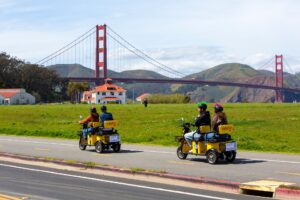Exploring the National AIDS Memorial Grove in San Francisco’s Golden Gate Park
San Francisco’s Golden Gate Park is not just a picturesque urban oasis; it’s also home to the National AIDS Memorial Grove, a poignant and meaningful tribute to those whose lives have been touched by AIDS. In this article, we’ll delve into the history and significance of this remarkable location, shedding light on its conception, national status, site revitalization, and its ongoing mission to ensure remembrance.
The Grove Story: A Place for Healing and Remembrance
The National AIDS Memorial Grove, nestled within the sprawling expanse of Golden Gate Park, serves as a dedicated space for millions of Americans directly or indirectly affected by AIDS. It’s a place where people can come together to heal, find hope, and remember. The Grove’s sacred ground, spanning 10 acres, honors all who confronted the tragic pandemic, including those who succumbed to it and those who shared their struggles, provided support, and kept vigils during the darkest hours.
Conception: The Birth of a Living Memorial
The idea for the National AIDS Memorial took root in 1988 when a group of San Francisco residents, deeply impacted by the AIDS epidemic, sought a positive outlet for their collective grief. They envisioned a serene place where individuals and groups could hold memorial services and remember amid the park’s rhododendrons and redwoods. The chosen site was the de Laveaga Dell, near the park’s tennis courts, which had fallen into disrepair due to budget cuts and lack of funding.
A team of architects, landscape architects, and designers generously volunteered their expertise to create a timeless living memorial. Site renovation commenced in September 1991 and is an ongoing endeavor. The Grove is not only a testament to civic beautification but also a prime example of a public-private partnership, garnering recognition and awards for its excellence in urban park restoration.
National Status: Recognized as a Vital Memorial
In October 1996, thanks to legislation led by Representative Nancy Pelosi and signed by President Bill Clinton, the ‘AIDS Memorial Grove Act of 1996’ officially designated the Grove as the National AIDS Memorial. This recognition places the Grove in the company of other significant national memorials like the Vietnam Veterans Memorial and the 9/11 Memorial & Museum, emphasizing its importance as a place for open grieving, comfort, and renewal for those affected by AIDS.
Site Revitalization: A Community’s Heartfelt Effort
At the core of the Grove’s success is the unwavering support of the community. Thousands of volunteers, from diverse backgrounds, have dedicated over 225,000 hours to participate in monthly Community Volunteer Workdays. These dedicated individuals have transformed the Grove from an overgrown, unusable space into a lush and tranquil haven.
Their efforts include clearing overgrowth, reintroducing native species through tree planting, and creating site improvements for public use. These improvements encompass flagstone gathering areas, Sierra granite boulders, and freestanding benches. A mobility path and gravel access ensure accessibility for all visitors. Seventeen defined areas are meticulously planted and maintained by volunteers, alongside the Grove’s full-time city gardener.
Ensuring Remembrance: A Lasting Legacy
To preserve the Grove as a living memorial for remembrance, reflection, inspiration, and action, a permanent endowment has been established. The Circle of Friends, situated within the Grove, plays a pivotal role in this endowment campaign. It’s important to note that the Grove exists today due to the generosity of individuals, philanthropic organizations, and corporations.
Governed by a dedicated board of directors and under the umbrella of the Tides Center, a non-profit dedicated to social service and environmental stewardship, the National AIDS Memorial Grove continues to stand as a beacon of hope and remembrance.
A Living History: Reflecting on the Past, Shaping the Future
The National AIDS Memorial began as a response to the AIDS pandemic nearly 30 years ago, providing a sacred space for grieving and healing. Today, it has evolved into an institution dedicated to ensuring that the lives lost to AIDS are never forgotten and that the story of AIDS is passed down to future generations.
Through initiatives like the AIDS Memorial Quilt, storytelling programs, scholarships, and awards, the National AIDS Memorial keeps the history and lessons of AIDS alive. It educates people worldwide about the devastating impact of AIDS and advocates for a world free from fear, silence, discrimination, and stigma.
Looking ahead, the National AIDS Memorial is exploring the possibility of creating a permanent national “Interpretive Center for Social Conscience” in San Francisco. This center would tell the story of AIDS in perpetuity and serve as a platform for advocating for human rights, emphasizing the interconnectedness of the fight against AIDS with other social justice struggles.
Supporting a Vital Mission
The National AIDS Memorial relies on funding from personal donors and corporate partners to sustain its mission and programs. If you want to learn more or contribute to this important cause, visit aidsmemorial.org.
In San Francisco’s Golden Gate Park, the National AIDS Memorial Grove stands as a testament to resilience, remembrance, and the power of community. It’s a place where history and hope intertwine, ensuring that the story of AIDS is never forgotten, and the fight for a better future continues.
More information: aidsmemorial.org
Info provided by SF Rec and Park Department







